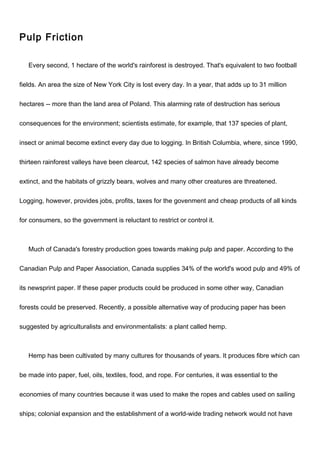Worksheet of skimming & scanning
- 1. Pulp Friction Every second, 1 hectare of the world's rainforest is destroyed. That's equivalent to two football fields. An area the size of New York City is lost every day. In a year, that adds up to 31 million hectares -- more than the land area of Poland. This alarming rate of destruction has serious consequences for the environment; scientists estimate, for example, that 137 species of plant, insect or animal become extinct every day due to logging. In British Columbia, where, since 1990, thirteen rainforest valleys have been clearcut, 142 species of salmon have already become extinct, and the habitats of grizzly bears, wolves and many other creatures are threatened. Logging, however, provides jobs, profits, taxes for the govenment and cheap products of all kinds for consumers, so the government is reluctant to restrict or control it. Much of Canada's forestry production goes towards making pulp and paper. According to the Canadian Pulp and Paper Association, Canada supplies 34% of the world's wood pulp and 49% of its newsprint paper. If these paper products could be produced in some other way, Canadian forests could be preserved. Recently, a possible alternative way of producing paper has been suggested by agriculturalists and environmentalists: a plant called hemp. Hemp has been cultivated by many cultures for thousands of years. It produces fibre which can be made into paper, fuel, oils, textiles, food, and rope. For centuries, it was essential to the economies of many countries because it was used to make the ropes and cables used on sailing ships; colonial expansion and the establishment of a world-wide trading network would not have
- 2. been feasible without hemp. Nowadays, ships' cables are usually made from wire or synthetic fibres, but scientists are now suggesting that the cultivation of hemp should be revived for the production of paper and pulp. According to its proponents, four times as much paper can be produced from land using hemp rather than trees, and many environmentalists believe that the large-scale cultivation of hemp could reduce the pressure on Canada's forests. However, there is a problem: hemp is illegal in many countries of the world. This plant, so useful for fibre, rope, oil, fuel and textiles, is a species of cannabis, related to the plant from which marijuana is produced. In the late 1930s, a movement to ban the drug marijuana began to gather force, resulting in the eventual banning of the cultivation not only of the plant used to produce the drug, but also of the commercial fibre-producing hemp plant. Although both George Washington and Thomas Jefferson grew hemp in large quantities on their own land, any American growing the plant today would soon find himself in prison -- despite the fact that marijuana cannot be produced from the hemp plant, since it contains almost no THC (the active ingredient in the drug). In recent years, two major movements for legalization have been gathering strength. One group of activists believes that ALL cannabis should be legal -- both the hemp plant and the marijuana plant -- and that the use of the drug marijuana should not be an offense. They argue that marijuana is not dangerous or addictive, and that it is used by large numbers of people who are not criminals but productive members of society. They also point out that marijuana is less toxic than alcohol or tobacco. The other legalization movement is concerned only with the hemp plant used to produce fibre; this group wants to make it legal to cultivate the plant and sell the fibre
- 3. for paper and pulp production. This second group has had a major triumph recently: in 1997, Canada legalized the farming of hemp for fibre. For the first time since 1938, hundreds of farmers are planting this crop, and soon we can expect to see pulp and paper produced from this new source. Worksheet 1: 1. How many species of salmon have become extinct in BC? 27 31 137 142 2. How much of the world's newsprint paper is supplied by Canada? 31% 49% 34% 19% 3. What equipment on a ship was made from hemp? Ropes waterproof cloth engine fuel life rafts 4. What drug can be obtained from a relative of hemp? cocaine heroin amphetamine marijuana 5. Where was hemp farming recently legalized?
- 4. the USA Canada Singapore the Netherlands Worksheet 2: The main idea of paragraph one is: Scientists are worried about New York City Logging is destroying the rainforests Governments make money from logging Salmon are an endangered species The main idea of paragraph two is: Canadian forests are especially under threat Hemp is a kind of plant Canada is a major supplier of paper and pulp Canada produces a lot of hemp The main idea of paragraph three is: Paper could be made from hemp instead of trees Hemp is useful for fuel Hemp has been cultivated throughout history Hemp is essential for building large ships The main idea of paragraph four is: Hemp is used to produce drugs Many famous people used to grow hemp It is illegal to grow hemp Hemp is useful for producing many things The main idea of paragraph five is: Hemp should be illegal because it is dangerous Recently, many people have been working to
- 5. legalize hemp Hemp was made illegal in 1938 Marijuana is not a dangerous drug The reading article is adopted from: http://web2.uvcs.uvic.ca/elc/studyzone/570/pulp/hemp3.htm




